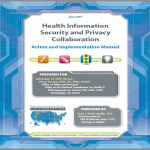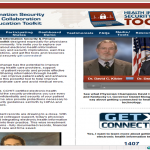Heading and the front page of Action and Implementation Manual link to pdf of the 45-page how-to guide produced from the 7 Collaborations among 42 states and territories referred to in the June 9, 2009 posting below.
http://healthit.hhs.gov/html/hispc/AIMReport.pdf
Category Archives: Digital Physicians
Provider Education Toolkit from ONC’s HISPC
Since a picture’s worth a 1,000 words, here’s the home page of the physician toolkit produced by one of the HISPC multi-state Collaborations, referenced in June 9, 2009 post.
http://www.secure4health.org
Health Information Security and Privacy Collaboration (HISPC): States Explain Privacy & Security Agreements
HISPC releases Action and Implementation Manual
Joseph Goedert of HealthData Management reported on June 5, 2009 that “The Health Information Security and Privacy Collaboration (HISPC) has released a how-to guide for state cooperation in health care privacy and security issues.” Referred to as AIM (Action and Implementation Manual), it’s the result of collaborative work between 42 states and territories. According to HISPC site, the ”AIM serves as a how-to guide for each of the seven multistate collaboratives’ tools and templates.”
AIM was prepared for Jodi Daniel, JD, MPH, Director and Steven Posnack, MHS, MS, Policy Analyst of the Office of Policy and Research of the Office of the National Coordinator for Health IT. AIM was prepared by Linda L. Dimitropoulos, PhD of RTI International, Chicago and released in June 2009.
HISPC Site: http://healthit.hhs.gov/HISPC
Action and Implementation Manual 45-page pdf:
http://healthit.hhs.gov/html/hispc/AIMReport.pdf
HISPC Phase 3 Executive Summary (Background on AIM) pdf: http://tinyurl.com/lyrdpb
HISPC June 2009 Seminar Series
“The Seminar Series will be held throughout the month of June on Tuesdays and Thursdays and will include eight 90-minute online seminars. Each seminar will highlight the work and results of the seven HISPC multi-state collaboratives as well as follow-up analysis on state law variation completed by Georgetown University. The HISPC Collaborative presentations will focus on the tools and processes developed and how they can be used by individual, local, regional, and state-level stakeholders.”
http://privacysecurity.rti.org/Default.aspx?tabid=101
HISPC Provider Education Toolkit Video
The HISPC Toolkit for physicians and other healthcare providers ”video {page down on the Press Kit and Tools Web page} was presented at the National HISPC Conference in Bethesda MD in March 2009 and provides a powerful message about electronic health information technology and exchange and the related privacy and security aspects. Please feel free to use this video at any event where health care providers would benefit from awareness of these issues and how to tap in to the Provider Education Toolkit websites and resources.”
http://www.secure4health.org/media.aspx
Health Information Security & Privacy Provider Education Toolkit
http://www.secure4health.org This Web site (including the video featured above) and its resources, built as one of the seven collaborative projects of HISPC, is a treasure and roadmap for educating providers and consumers. “Welcome to the Health Information Security & Privacy Provider Education Toolkit designed especially for physicians and the healthcare community. We invite you to explore our Web site, learn more about electronic health information exchange, related privacy and security implications, earn free CME credits, ask questions, and get the tools and resources you need to safely and securely get connected! ”
http://www.secure4health.org
Thanks to Fred Pennic of Healthcare IT Consultant Blog
Today’s email update from Healthcare IT Consultant Blog, produced by Fred Pennic, and his brief on the HISPC release of AIM, brought the program to my attention and led me down the path of discovery of these resources. Thank you Fred Pennic.
http://hitconsultant.blogspot.com
HISPC National Conference: March 4-6, 2009 Bethesda, MD
Presentations from ”conference showcased the common, replicable solutions developed by seven multi-state collaboratives to the privacy and security challenges presented by the implementation of electronic health information exchange at the state and organizational level.”
HISPC site with relevant working documents: http://privacysecurity.rti.org/
89% of Online US Physicians: Internet Essential to Practice
Manhattan Research: Online physicians increasingly embrace Internet resources
iHealthBeat reported on series of Manhattan Research surveys showing that US physicians who say that ”the Internet is essential to their professional practice” increased to 89% of online US physicians, 88% of online South Korean physicians, 87% of online Australian physicians and 81% of online European physicians
http://www.ihealthbeat.org/Data-Points/2009/What-Percentage-of-Physicians-Report-That-the-Internet-Is-Essential-to-Their-Professional-Practice.aspx Manhattan Research
Patient Centered Computing and eHealth
Transforming Healthcare Quality
A CME Course from Harvard for nurses, physicians, public health, Information Technology
May 1-3, 2009
Offered by Center for Information Technology Leadership
and Partners HealthCare System
http://partnerscird.blogspot.com/2009/04/please-consider-joining-us-for-harvard.html
“This practical course presents the work of national experts in patient‑centered computing and eHealth using a format that will enable acquisition of knowledge and skills. Through presentations, panel discussions and workshops, participants will interact with these experts about the opportunities and challenges that arise from the implementation and use of patientcentered computing.”
Course Director: Blackford Middleton,MD, MPH, MSc
Course Co‑Directors: Patricia C. Dykes, DNSc, MA, RN and Douglas Johnston
Blackford Middleton reported on one panel from the course “Two providers from the Partners Healthcare System (both MGH docs as it turns out), and two of their patients shared the stage for a bit to each offer their perspectives on doctor-patient email, use of the PHR, and what does it all mean in terms of the e-enabled doctor-patient relationship, and more.”


